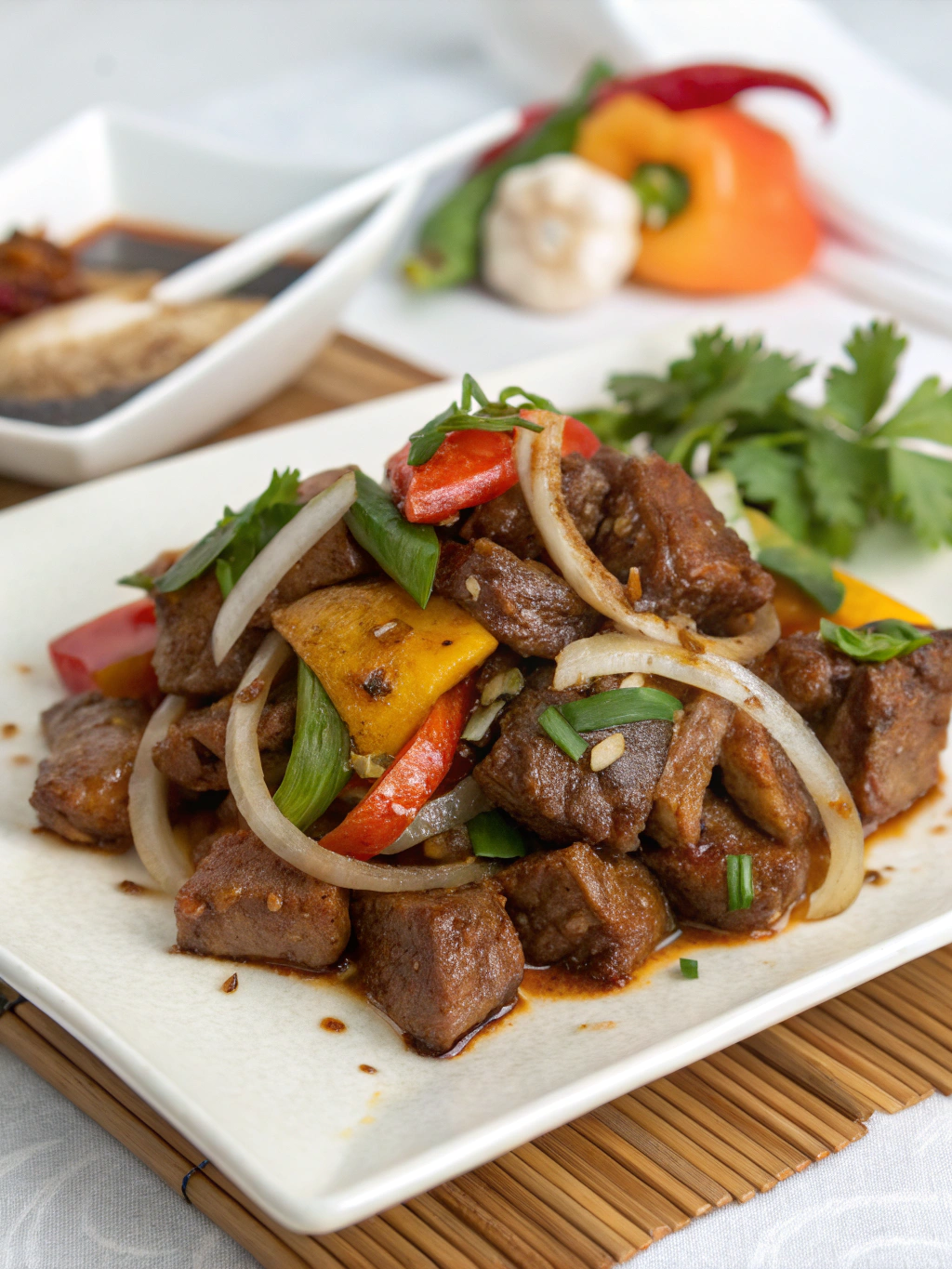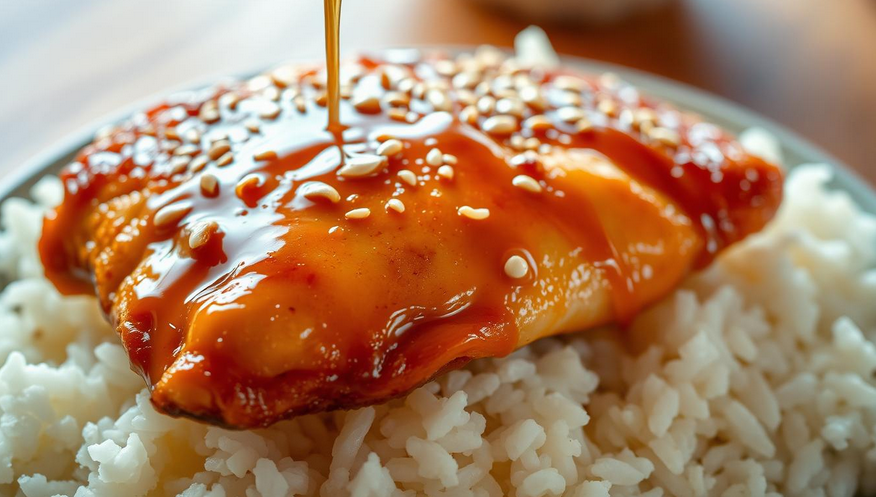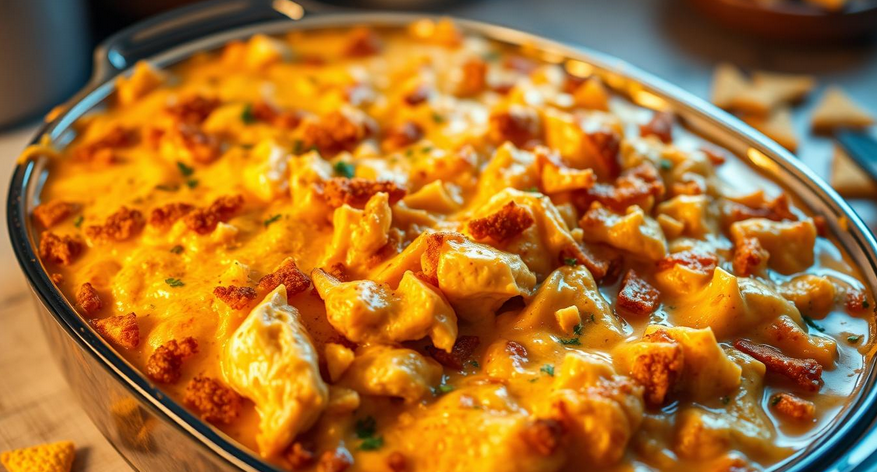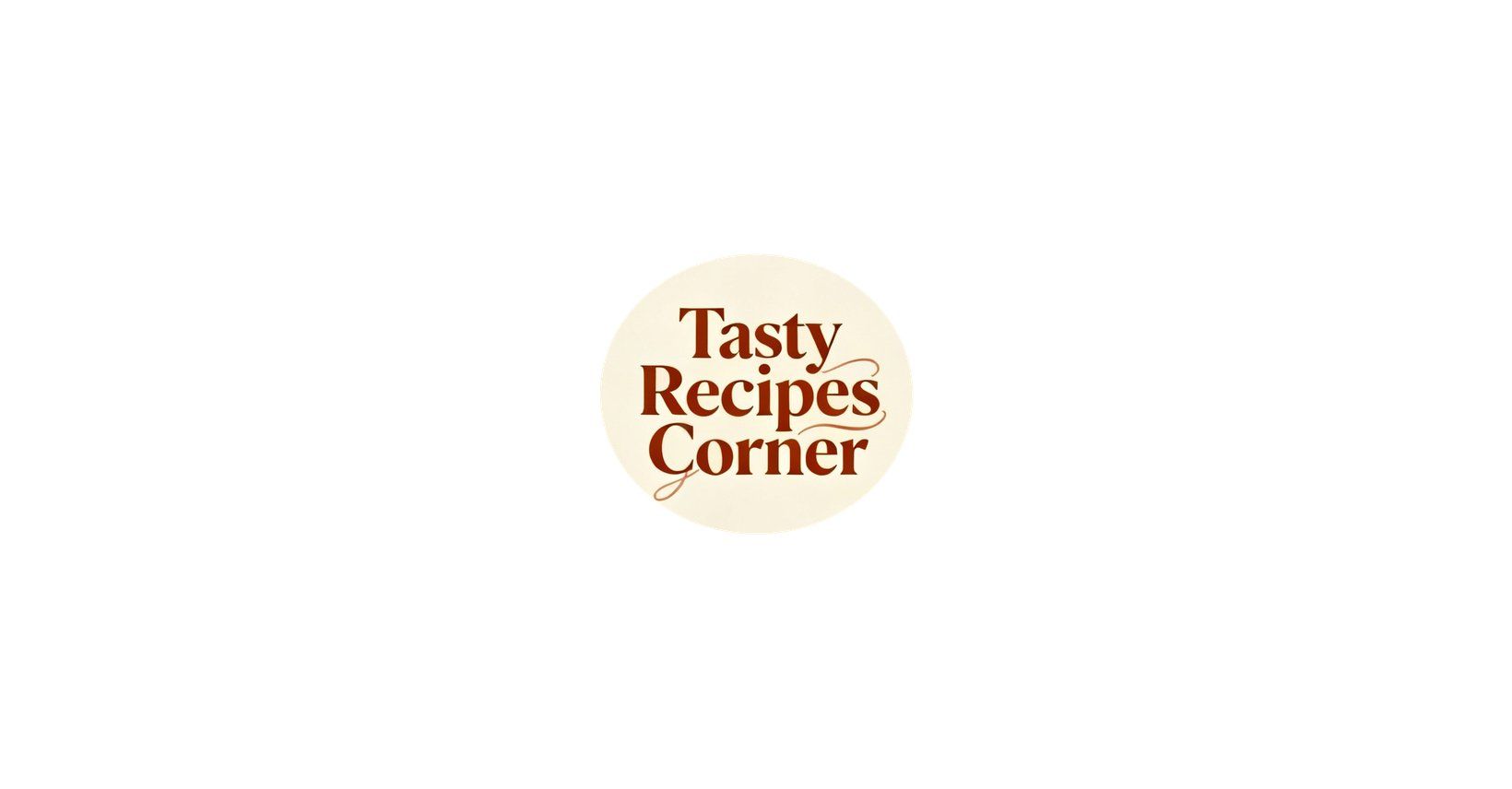Best Smoked Mac and Cheese Recipe
Table of Contents
The best smoked mac and cheese recipe turns comfort food into a smoky sensation. It infuses classic mac and cheese with wood-fired flavors. This makes it a standout at BBQs or family meals.
Smoking adds layers of taste. Every bite is a mix of creamy cheese and subtle smoke.
This guide breaks down every step. It goes from choosing the right cheese blends to mastering your smoker’s settings. Whether you’re using a Traeger pellet grill or a charcoal smoker, you’ll learn how to avoid common mistakes.
Common mistakes include cheese separation or over-smoking. Every tip ensures your smoked mac and cheese recipe becomes a go-to for gatherings or casual nights.
Key Takeaways
- Use smoky flavors to elevate classic mac and cheese into a crowd favorite.
- Discover how cheese choices like Velveeta or smoked Gouda affect the final taste.
- Learn precise smoker techniques to achieve even cooking and perfect texture.
- Get solutions for fixing dryness or uneven smoky notes instantly.
- Follow expert tips for pairing wood chips with cheese varieties.
What Makes Smoked Mac and Cheese So Irresistible
Smoke turns regular mac and cheese into a dish you can’t stop thinking about. It’s not just about taste—it’s a mix of science and magic.
The Science Behind Smoke-Infused Flavor
Smoke’s smells mix with cheese fats, creating deep flavors. When you smoke mac n cheese, heat makes the Maillard reaction happen. This reaction brings out the umami in the cheese.
Cheeses like cheddar or gouda soak up smoke well. They turn simple ingredients into something amazing.

Why This Comfort Food Classic Gets Better with Smoke
Smoke adds a new layer to creamy mac and cheese. It balances saltiness with smoky warmth. This mix makes every bite feel like a treat.
Studies show smoky flavors tap into our primal cravings. This makes each bite feel like a special reward.
Smoked vs. Traditional Mac and Cheese: Key Differences
- Texture: Smoke makes the surface slightly dry, adding a nice crunch to the gooey cheese.
- Flavor: Smoked versions have rich, layered flavors from different woods (like hickory or mesquite).
- Method: Smoking uses low-and-slow heat, unlike oven-baked methods.
These changes make a classic dish feel both familiar and new. Every bite tells a story of fire and comfort.
Essential Equipment for Your Smoked Mac and Cheese
Starting with easy smoked mac and cheese requires the right tools. Whether you’re a pro or new, a few key items are essential. Here’s what you need:
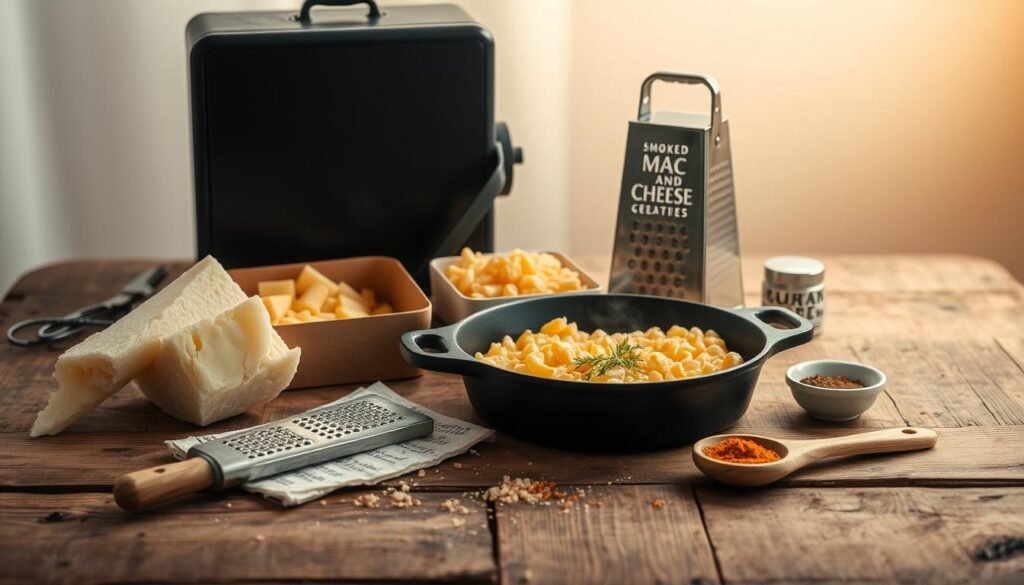
- Smoker types: Offset, vertical, electric, or pellet smokers work. Pellet smokers like Traeger offer precise temperature control.
- Heat-safe pans: A cast iron skillet or aluminum baking dish distributes heat evenly without warping.
- Thermometer: Use a meat or probe thermometer to monitor internal cheese temperature (165°F is ideal).
- Wood chips: Choose applewood or hickory for mild smoke; soak chips 30 minutes before use.
- Drip pan: Place under your dish to catch drips and add moisture during smoking.
Don’t have a smoker? Kettle grills with smoking pouches or stovetop smokers like Weber or Masterbuilt work too. A reliable thermometer is key to avoid undercooked cheese. Even basic equipment can lead to delicious results without spending a lot. Focus on quality pans and consistent heat for perfect easy smoked mac and cheese every time.
Ingredients for the Ultimate Smoked Mac and Cheese Recipe
Creating homemade smoked mac and cheese requires the right ingredients. Each part, from cheese to pasta, is crucial. They balance smoke, creaminess, and texture. Let’s explore each component to make your dish stand out.
Cheese Selection: Types That Smoke Best
For meltability, choose cheeses with high fat content. Sharp cheddar adds sharpness, while smoked gouda brings a nutty flavor. Gruyère adds umami. Use block cheeses like Kerrygold cheddar for better melting.
Pasta Options and Why They Matter
- Elbow macaroni: Its shape traps sauce well.
- Cavatappi: Spiral ridges hold more cheese for richer bites.
- Shells: Great for layered casseroles or baked versions.
Creating the Perfect Roux
To make a roux, mix equal parts butter and flour. Melt 1/2 cup butter, then whisk in 1/2 cup flour. Cook until it’s golden (about 5 minutes). This thickens the sauce without lumps. But, don’t overcook it, or your homemade smoked mac and cheese might taste bitter.
Optional Add-ins for Extra Flavor
Add smokiness with Colman’s English mustard or paprika. For texture, try cooked bacon bits or sautéed onions. For a spicy kick, sprinkle red pepper flakes. Always taste as you go.
Preparing Your Smoker for Mac and Cheese Success
Getting your smoker ready is the first step toward perfect smoked mac n cheese recipe results. These three steps ensure even cooking and rich flavor without overcomplicating the process.
Temperature Control Tips
- Keep the smoker between 225°F and 250°F. Use vents to balance airflow and avoid sudden heat changes.
- Add a water pan below the cooking dish to stabilize temps and protect the cheese from burning.
- Monitor heat closely to prevent sauce separation caused by extreme fluctuations.
Wood Chip Selection for Optimal Flavor
Mild woods like apple or cherry add gentle smoky hints, pairing best with creamy cheeses like gouda or cheddar. For sharper flavors, mix hickory with mild chips to avoid overpowering the dish. Avoid mesquite alone unless combining with mild woods.
Preheating Strategies
- Preheat your smoker to target temp before adding the mac and cheese. Charcoal smokers need 15-20 minutes; electric models take 10-15 minutes.
- In cold weather, add 15 extra minutes to ensure stable heat for your smoked mac n cheese recipe.
Proper prep ensures the cheese melts evenly and the smoky flavor enhances—not overwhelms—the dish. Adjust timing and wood choices based on your equipment and weather conditions.
Step-by-Step Smoked Mac and Cheese Recipe
Begin by boiling elbow macaroni until it’s al dente. Drain it and set it aside. In a saucepan, melt butter over medium heat. Then, whisk in flour to make a roux, cooking for 2 minutes.
Slowly add milk, stirring constantly until it thickens. Remove it from the heat.
Mix in shredded cheddar, gouda, and pepper jack cheeses until they melt. Add cooked macaroni and ½ cup of pasta water for creaminess. Fold in diced cooked bacon for smoky flavor. Transfer it to a foil-lined baking dish.
- Spread the mixture evenly. Cover loosely with foil.
- Smoke at 225°F for 45 minutes using applewood chips.
- Remove foil and increase heat to 300°F for 15 minutes to form a golden crust.
Before serving, top with crushed Ritz crackers and extra bacon bits. Let it rest for 5 minutes to keep the creamy smoked mac and cheese texture. Serve immediately for the best taste.
Pro tip: Add 2 tablespoons of cream cheese to the sauce for extra silkiness. Avoid over-stirring after adding cheese to prevent separation. Always use sharp cheeses for maximum flavor infusion during smoking.
Using a Traeger or Pellet Grill for Smoked Mac and Cheese
Mastering smoked mac and cheese on a Traeger or pellet grill is easy with these tips. Pellet grills offer steady heat, perfect for slow cooking. The smoked mac and cheese traeger method makes it simple with automation.
Temperature Settings for Pellet Smokers
| Model | Ideal Temp (°F) | Tips |
|---|---|---|
| Traeger Pro Series | 225-250 | Use indirect heat settings |
| Ironwood 850 | 225-250 | Enable Super Smoke mode for 30 mins at start |
| Timberline | 225-250 | Monitor airflow vents |
Timing Considerations
- Cook for 1.5-2 hours at 225°F
- Check internal temp reaches 165°F
- Use the grill’s probe alerts to avoid overcooking
Traeger-Specific Tips
“Traeger’s Super Smoke mode adds 2x smoke intensity for deeper flavor.”
- Use Apple or Hickory pellets for mild sweetness
- Activate keep-warm mode at 170°F post-cook
- Test Competition blend for a clean, smoky base
Try your favorite cheeses for a delicious smoked mac and cheese pellet grill dish. Adjust pellets and smoke settings to your taste.
Creating Creamy Smoked Mac and Cheese with Velveeta
When making smoked mac and cheese with velveeta, its unique texture shines. Velveeta’s modified food starch makes it silky smooth. Start by cubing cold Velveeta for even melting, then blend it with sharp cheddar in a 2:1 ratio. This balances creaminess with authentic cheese depth.
- Ratios Matter: Use twice as much Velveeta as other cheeses to avoid overpowering its mild flavor.
- Timing: Add cubed Velveeta last in the sauce to prevent overcooking. Stir gently until fully melted.
- Seasoning: Reduce salt in the sauce since Velveeta contains sodium. Let smoked flavors take center stage.
Smoke at 225°F for 1.5 hours to infuse subtle hickory notes without overwhelming the cheese. For extra richness, top with crispy bacon bits or green chiles before serving. The result? A smoked mac and cheese with velveeta that’s reliably creamy, even for first-time smokers. Families love its consistent texture, making it a foolproof crowd-pleaser.
Homemade Smoked Gouda Mac and Cheese Variation
Turn your mac and cheese into a fancy dish with smoked gouda. This cheese has a rich, nutty taste from being smoked. For the best taste, use Dutch brands like Boerenkaas.
Why Smoked Gouda Creates Depth of Flavor
Smoked gouda is pre-smoked, so it doesn’t need as much grill time. This lets its caramelized flavors shine. Younger gouda (4-6 months) melts better, while older (6-18 months) has a tangier taste.
| Age | Meltability | Flavor Profile |
|---|---|---|
| 4-6 months | Smooth | Buttery, lightly smoky |
| 12-18 months | Chunky | Peppery, caramelized |
Complementary Cheeses to Pair with Gouda
- Fontina: 1:2 ratio with gouda for creaminess
- Gruyère: Adds nutty complexity (try Kraft Gruyère)
- White cheddar: Balances smokiness with sharpness
Adjusting Cooking Times for Different Cheese Blends
When mixing gouda, adjust your smoker’s settings:
| Cheese Blend | Smoke Time | Temp |
|---|---|---|
| 100% Gouda | 30 mins | 225°F |
| Gouda + Fontina | 45 mins | 200°F |
Try it with caramelized onions or thyme for a wow-worthy dish. Make sure to keep the cheese mix right to avoid separation. Gouda’s firmness needs slow, low heat.
Elevating Your Dish: Smoked Mac and Cheese with Bacon
Adding bacon makes smoked mac and cheese a hit. Learn how to mix smoky, salty, and creamy flavors just right.
Preparing Bacon for Maximum Flavor
Choose thick-cut bacon for better smoking. Render bacon fat to add to cheese sauces. Cook until crispy, then chop for texture.
Pro tip: pre-smoke bacon with your dish for a unified taste.
- Option 1: Cook bacon to 75% before adding to the dish.
- Option 2: Smoke raw bacon with your dish.
- Option 3: Mix crispy bits with rendered fat for depth.
Integrating Bacon Throughout the Dish
Make every bite special by:
- Mixing crumbled bacon into cheese sauce
- Wrapping cheese cubes in bacon
- Layering pasta and bacon
- Finishing with bacon salt
Keep it from getting greasy by saving 25% of bacon fat for veggies.
Smoke-Friendly Bacon Varieties
Applewood-smoked bacon is great with sharp cheddar. Hickory bacon pairs well with smoky sauces. Maple-cured bacon complements gouda. Peppered bacon adds a nice aroma without overpowering.
Try different bacon and cheddar mixes to find your perfect flavor.
Mastering Smoked Mac and Cheese on the Grill
Smoking mac and cheese on the grill is easy without a smoker. Just use your charcoal or gas grill with a few tweaks. First, set up indirect heat zones to prevent burning. Here’s how to adjust for different grill types:
- Kettle Grill: Put charcoal on one side and a pan with wood chips on the hot side. Cook the mac and cheese on the other side.
- Gas Grill: Heat all burners to medium, then turn off one side. Place wood chips in foil with holes on the lit side. Cook over the unlit side.
- Kamado: Use a two-zone fire with a chimney starter. Add soaked wood chunks directly to the coals.
Use a heavy-duty baking dish wrapped in foil to keep it moist. For gas grills, seal it tightly with foil to trap smoke. Keep an eye on the temperature—it heats up fast. Aim for 225–250°F and check every 30 minutes. Add soaked wood chips every 45 minutes to keep the flavor.
If it starts to dry out, mist the top with water before finishing. Charcoal users should layer wood chunks with charcoal for steady smoke. Even without a smoker, smoked mac and cheese on the grill gets deep smoky flavors. Check the pasta’s internal temperature—165°F means it’s cooked. Serve it right away to enjoy the smoky creaminess.
Troubleshooting Common Smoked Mac and Cheese Problems
Getting your smoked mac and cheese just right can be tricky. But with these tips, you can keep it moist, creamy, and full of flavor every time.
Preventing Dry Mac and Cheese
To avoid dry pasta, add cream cheese or evaporated milk to the sauce before smoking. Use a covered dish and watch the heat. If it’s already dry, warm it up slowly with a bit of warm broth.
Fixing Cheese Separation
Cheese can separate if it’s overcooked or not melted enough. Start with a good roux and mix in cheeses like cheddar or gouda. Keep the smoker at 225°F (107°C) and stir gently if needed.
Adjusting for Weather Conditions
Cold or humid days can slow down smoking. Preheat your smoker longer and wrap dishes loosely in foil to keep heat in. On windy days, block drafts with vents and cook 15-20% faster. Always check your Traeger or pellet grill manual for weather tips.
With these fixes, you can turn any problem into a success. Whether it’s adjusting for the weather or fixing texture, these steps will help. Keep practicing to make sure your next batch of smoked mac and cheese is perfect.
FAQ
What is the best smoked mac and cheese recipe?
The top recipe combines sharp cheddar and smoked gouda for a creamy, flavorful dish. Adding cream cheese or Velveeta boosts creaminess. Bacon adds a smoky taste.
How do I make easy smoked mac and cheese?
Start by cooking pasta until it’s al dente. Then, mix a cheese sauce with your favorite cheeses. Smoke it at 225-250°F using wood chips for flavor. This method is simple and delicious.
Can I use a Traeger for smoked mac and cheese?
Yes, a Traeger or pellet grill is great for smoked mac and cheese. Set it to 225-250°F and follow your recipe. The Traeger’s consistent heat and smoke enhance the flavor.
What types of cheese work best for smoked mac and cheese?
Sharp cheddar, smoked gouda, and gruyère are the best. They melt well and complement the smoky taste without being greasy.
How can I make creamy smoked mac and cheese?
Use a roux base and add cheese slowly to avoid overcooking. Cream cheese or Velveeta can also keep it creamy.
Is smoked mac and cheese on the grill possible?
Absolutely! Grill it by setting up indirect heat and adding wood chips for flavor. The grilling adds a unique taste.
What are some optional add-ins for smoked mac and cheese?
Try adding cooked bacon, jalapeños, caramelized onions, and breadcrumbs. These add flavor and texture.
How do I prevent my smoked mac and cheese from drying out?
Keep the cheese sauce moist before smoking. Cover it with foil at first. Cream cheese or evaporated milk can also help.
What’s the difference between smoked mac and cheese and traditional mac and cheese?
Smoked mac and cheese has a smoky flavor from wood smoke. Traditional mac and cheese is cheesy and creamy without this deep flavor.
Can I use different types of pasta for my smoked mac and cheese?
Yes, try different pasta shapes like cavatappi, penne, or shells. They hold cheese sauce differently and add texture.
What did you think of our recipe?
There are no reviews yet. Be the first one to write one.


